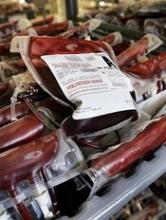ANAHEIM, CA—Results of a large study suggest a restrictive transfusion strategy is safe for moderate- to high-risk patients undergoing cardiac surgery.
Researchers found that patients had similar rates of various outcomes—death from any cause, myocardial infarction, stroke, or new-onset renal failure with dialysis—whether they received red blood cell (RBC) transfusions according to a restrictive strategy or a liberal one.
C. David Mazer, MD, of St. Michael’s Hospital in Toronto, Ontario, Canada, presented these results at the American Heart Association’s Scientific Sessions 2017.
Results were simultaneously published in NEJM.
Dr Mazer and his colleagues studied 5243 adults undergoing cardiac surgery. They all had a European System for Cardiac Operative Risk Evaluation I score of 6 or more (on a scale from 0 to 47, with higher scores indicating a higher risk of death after cardiac surgery).
Patients were randomized to receive RBC transfusions according to a restrictive strategy or a liberal one.
With the restrictive strategy, patients received transfusions if their hemoglobin level was below 7.5 g/dL, starting from induction of anesthesia.
With the liberal strategy, patients were transfused if their hemoglobin level was less than 9.5 g/dL in the operating room or intensive care unit (ICU) or was less than 8.5 g/dL in the non-ICU ward.
Results
There were 4860 patients in the per-protocol analysis—2430 in each transfusion group. Baseline characteristics were similar between the groups.
The rate of RBC transfusion was 52.3% in the restrictive group and 72.6% in the liberal group. The odds ratio (OR) was 0.41 (95% confidence interval [CI], 0.37 to 0.47).
Transfused patients received a median of 2 RBC units (interquartile range [IQR], 1 to 4) in the restrictive group and 3 units (IQR, 2 to 5) in the liberal group.
The study’s primary composite outcome was death from any cause, myocardial infarction, stroke, or new-onset renal failure with dialysis by hospital discharge or by day 28, whichever came first.
This outcome occurred in 11.4% of patients in the restrictive group and 12.5% of those in the liberal group. The absolute risk difference was −1.11 percentage points (95% CI, −2.93 to 0.72), and the odds ratio was 0.90 (95% CI, 0.76 to 1.07; P<0.001 for noninferiority).
There were no significant differences between the groups when it came to the individual components of the composite outcome.
“We have shown that this [restrictive] approach to transfusion is safe in moderate- to high-risk patients undergoing cardiac surgery,” Dr Mazer said.
“Such practices can also reduce the number of patients transfused, the amount of blood transfused, the impact on blood supply, and costs to the healthcare system.”


